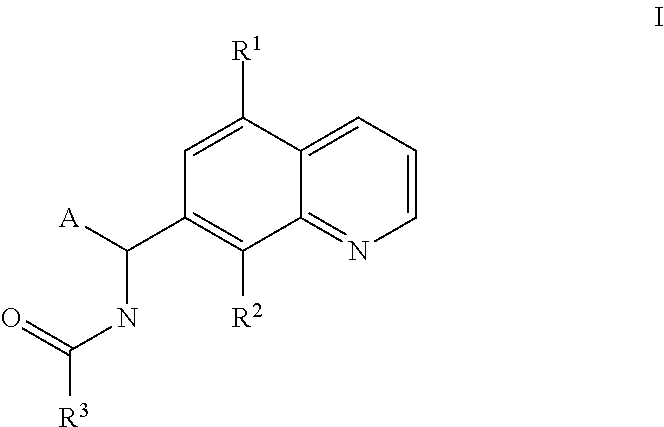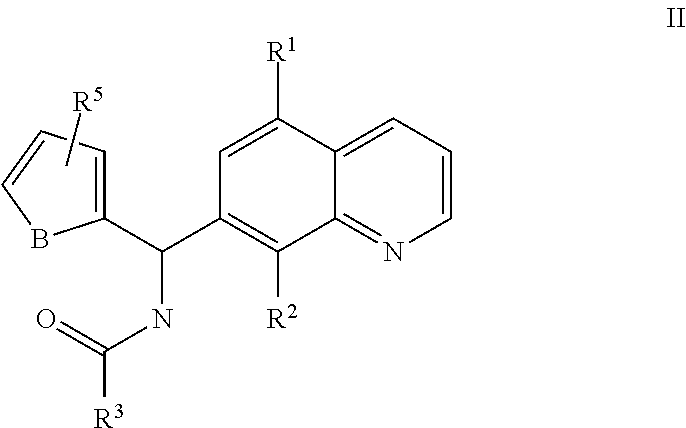Small molecule activators of mitochondrial function
a small molecule and activator technology, applied in the field of small molecule activators of mitochondrial function, can solve the problems of further damage to mtdna, vicious cycle, difficulty in walking,
- Summary
- Abstract
- Description
- Claims
- Application Information
AI Technical Summary
Benefits of technology
Problems solved by technology
Method used
Image
Examples
example 1
Preparation of Compounds of the Invention
[0392]The practitioner has a well-established literature of small molecule chemistry to draw upon, in combination with the information contained herein, for guidance on synthetic strategies, protecting groups, and other materials and methods useful for the synthesis of the compounds of this invention.
[0393]The various references cited herein provide helpful background information on preparing compounds similar to the inventive compounds described herein or relevant intermediates, as well as information on formulation, uses, and administration of such compounds which may be of interest.
[0394]Moreover, the practitioner is directed to the specific guidance and examples provided in this document relating to various exemplary compounds and intermediates thereof.
[0395]The compounds of this invention and their preparation can be understood further by the examples that illustrate some of the processes by which these compounds are prepared or used. It...
example 2
Results of Screening
[0427]Single dose assay: An activity threshold of >1.32 fold increase in absorbance over the cell control was calculated as greater than three standard deviations from the median compound Fold Increase. Therefore, compounds that exhibited >1.32 fold increase in absorbance were selected as candidates for the follow-up dose response assay.
[0428]The following compounds were active in the screen: N-[(5-chloro-8-hydroxyquinolin-7-yl)-thiophen-2-ylmethyl]-3-phenylpropanamide, N-[(5-chloro-8-hydroxyquinolin-7-yl)-thiophen-2-ylmethyl]pentanamide, N-[(8-hydroxy-5-nitroquinolin-7-yl)-thiophen-2-ylmethyl]butanamide, N-[(8-hydroxy-5-nitro-quinolin-7-yl)-thiophen-2-yl-methyl]-acetamide, N-[(8-hydroxy-5-nitro-quinolin-7-yl)-thiophen-2-yl-methyl]-propionamide, N-[2-furyl(8-hydroxy-5-nitro-7-quinolinyl)methyl]butanamide, N-[(8-Hydroxy-5-nitro-quinolin-7-yl)-p-tolyl-methyl]-propionamide, N-[{8-hydroxy-5-nitro-7-quinolinyl}(4-methylphenyl)methyl]acetamide, N-[(5-chloro-8-hydroxyqu...
example 3
Additional Screening Assays
[0429]One additional screen employs the murine myoblast (C2C12) cell line treated with ferric ammonium citrate (FAC) and L-buthionine (S,R)-sulfoximine (BSO), using ATP measurements. Approximately 4000 cells per well are plated in standard medium in 96-well plates and FAC is added 4 hours later. The cells are incubated overnight (20 h) in standard tissue-culture incubators, after which BSO is added. After another overnight incubation (24 h) ATP content is determined using the CellTiter-Glo assay. The synergistic effects of FAC and BSO in decreasing viability, as measured by ATP content, presumably derive from the combination of increased oxidative stress (secondary to the FAC) with decreased cellular antioxidant capacity (secondary to the BSO).
[0430]Cells treated with the compounds embodied herein show a statistically significant improvement in resistance to treatment with FAC and / or BSO, as indicated by a statistically significant improvement in ATP conte...
PUM
| Property | Measurement | Unit |
|---|---|---|
| temperature | aaaaa | aaaaa |
| volume | aaaaa | aaaaa |
| volume | aaaaa | aaaaa |
Abstract
Description
Claims
Application Information
 Login to View More
Login to View More - R&D
- Intellectual Property
- Life Sciences
- Materials
- Tech Scout
- Unparalleled Data Quality
- Higher Quality Content
- 60% Fewer Hallucinations
Browse by: Latest US Patents, China's latest patents, Technical Efficacy Thesaurus, Application Domain, Technology Topic, Popular Technical Reports.
© 2025 PatSnap. All rights reserved.Legal|Privacy policy|Modern Slavery Act Transparency Statement|Sitemap|About US| Contact US: help@patsnap.com



